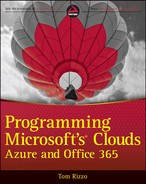Contents
Part I: An Introduction to Microsoft’s Cloud
Chapter 1: Welcome to the Cloud
Understanding the Cloud Approach to Services
Deciding to Move into the Cloud
Content Delivery Network (CDN)
Office Professional Plus and Office Web Apps
Chapter 2: Getting Your Environment Ready for Office 365
Your Office 365 Cloud Environment
Registering for Office 365 (Trial)
Your Office 365 Development Environment
Using Virtualization for Your Development Environment
Using Microsoft Trial Virtual Machines
Using a Physical Machine for Your Development
Creating an Office 365 Development Environment
Step 1: Installing Mandatory Software
Step 2: Installing Service-Specific Software
Step 3: Finalizing Installation
Your First Office 365 Application
Your First SharePoint Online Solution
Your First Exchange Online Application
Your First Lync Online Application
Office 365 Development Challenges
Office 365 Developer Resources
Quick Start Office 365 Development
Chapter 3: Office 365 Identity Services
Understanding Identity in Office 365
Establishing Identity Using Only Office 365 Identities
Using Office 365 with On-Premises Active Directory
Chapter 4: Introducing SharePoint Online
SharePoint Online—A Brief Technical Overview
SharePoint Online Versus SharePoint On-premises
Developing for SharePoint Online
Part III: Developing Office 365
Chapter 5: SharePoint Online Development
Deploying and Debugging Your Solutions
Differences Between SharePoint On-Premises and Online
What’s in SharePoint Online in Office 365?
Writing SharePoint Online Applications
Identity and Authentication in Office 365
Developing for SharePoint Online
Calling the Client Object Model
List, View, and Event Enhancements
Status Bar and Notification Area
Calling SharePoint Web Services
Types of Solutions You Can Build
Building Declarative Workflows
SharePoint Designer Workflow Designer
Building Workflow Actions in the Sandbox
Connecting BCS to Windows Azure
Chapter 6: Exchange Online Development
Introducing Exchange Online in Office 365
Exchange On-Premises Versus Exchange Online
Introducing the Exchange Web Services Managed API
Administering Exchange Online Using PowerShell
Building Applications for Exchange Online
Working with the Autodiscover Service
Working with Streaming Notifications
Chapter 7: Lync Online Development
Introducing Lync Online in Office 365
Lync On-Premises Versus Lync Online
Developing Applications for Lync Online
Working with the Lync Controls
Starting Conversations Using Automation
Working with Extensibility Applications
Registering for a Windows Azure Account
Managing the Windows Azure Environment
Getting Your Development Environment Ready
What Language Should You Choose?
Windows Azure Tools for Visual Studio
Developing a Windows Azure Application
Using the Configuration Dialogs
Deploying from Staging to Production
Programmatically Controlling Your Service
Understanding the Service Management API
Understanding Federated Identity
Windows Identity Foundation Overview
Working with Windows Identity Foundation
Creating a Claims-Aware Website
Creating a Claims-Aware Web Service
Getting WIF to Work on Windows Azure
Chapter 10: Leveraging Blob Storage
Understanding Blobs and Blob Storage
Understanding the Blob Hierarchy
Creating the Authorization Header
The Difference Between SQL Server and SQL Azure
Getting Started with Your First SQL Azure Database
Using SQL Server Management Studio
Accessing SQL Azure from Applications
Accessing SQL Azure from Azure-Hosted Applications
Accessing SQL Azure from On-Premises Applications
Troubleshooting Connection Loss
Chapter 12: An Azure Datamarket Overview
What Is Windows Azure Datamarket?
Working with the Service Explorer
Building a Fixed Query Datamarket Application
Building a Flexible Query Datamarket Application
Understanding Service Bus Brokered Messaging
Understanding Service Bus Relayed Messaging
Programming Service Bus Brokered Messaging
Building a Managed Queue Client
Programming Topics and Subscriptions
Choosing Between Managed and REST Service Bus Clients
Comparing Service Bus Brokered Messaging to Azure Queues
Service Bus Billing and Quotas
Chapter 14: AppFabric: Access Control Service
What Is the Access Control Service?
Access Control Service Architecture
Access Control Service Fundamentals
Getting Started with the Access Control Service
Configuring Additional Identity Providers
Customizing the Access Control Service
Enhancing the Login Experience
Working with Service Identities
Federating from a Local Network with ADFS 2.0
Modifying the Token with Rule Groups
Windows Azure Connect Versus Service Bus
How the Azure Service Bus Works
Which Technology Should You Choose?
Windows Azure Connect Fundamentals
Setting Up Windows Azure Connect
Requesting Access to the Azure Connect CTP
Enabling and Configuring Azure Connect for Azure Roles
Enabling and Configuring Azure Connect for a VM Role
Enabling and Configuring Your Local Machines
Configure Your Network Connectivity Policy
Testing Connectivity to SQL Server
Building a Domain-Joined Configuration
Troubleshooting Windows Azure Connect
Chapter 16: Azure Diagnostics and Debugging
What Is Windows Azure Diagnostics?
Using Windows Azure Diagnostics
Chapter 17: When to Use Azure Versus Office 365
Which Service is More Flexible?
How Does Each Service Handle Identity Federation?
What Productivity Tools Does Each Offer?
How Does Each Handle Cross-Platform Support
How Do Service-Level Agreements Work?
What Development Tools Do Azure and Office 365 Support?
